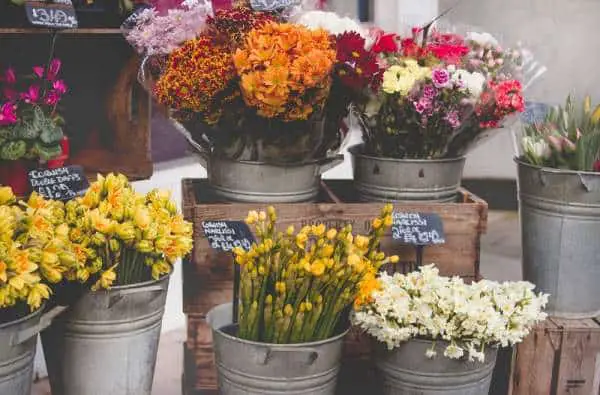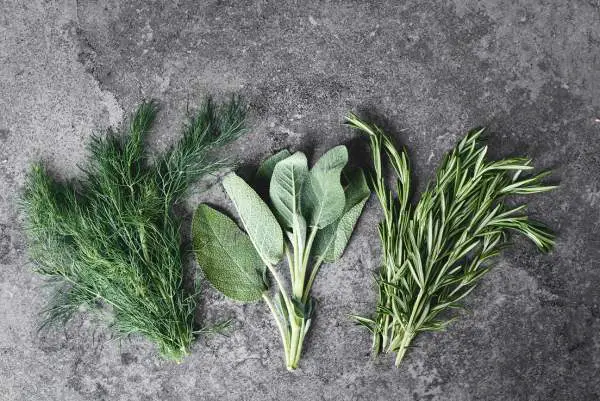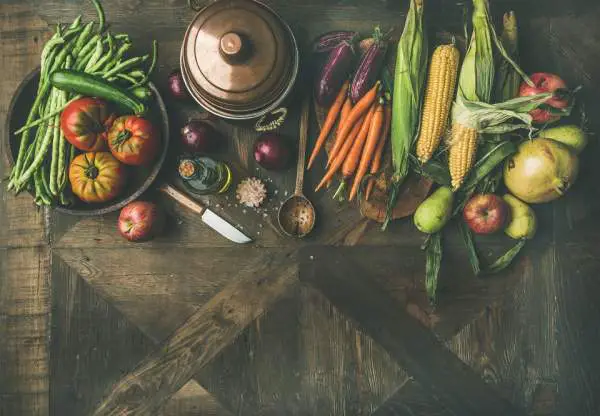Why Hydroponic Flowers?
Flower gardeners spend countless hours tilling and tending to the soil. This makes flower gardening appear hard to work, and if it takes this much effort, then why would you consider growing plants in a hydroponic system?
There are in fact several benefits and advantages flower gardening in hydroponics has over soil growing.
Results come much faster, you can tailor your nutrients to each plant species, and you have no weeds, insects, and less disease to contend with. This delivers up to a fifty percent faster growth in flowers, and yields are much greater than compared to soil growth.
With this in mind, you can now grow flowers all year round, and which can be expensive to purchase when out of season. You can also have as many cut flower displays around your home as you wish.
These are nine of the best flowers you can grow in your hydroponic system. If you don’t already have a hydroponic system, read this article for diy hydroponic system ideas.
- Peace lilies
- Hoya
- Snapdragons
- Dahlias
- Rex begonias
- Carnations
- Orchids
- Petunia
- Zinnia
Top 9 Hydroponic Flowers
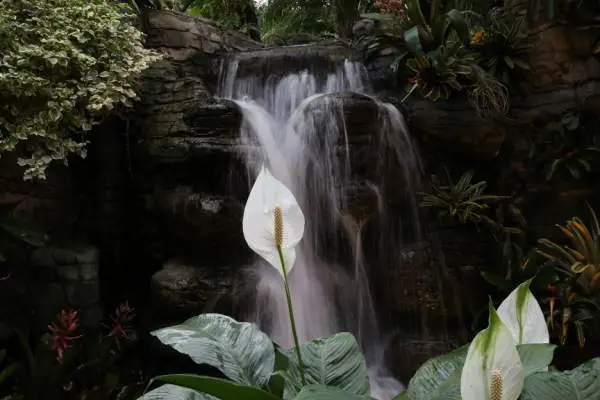
Peace Lilies
As an indoor plant, the Peace Lily can be one of the easiest to care for. You need the right growing conditions though. These tropical flowers are part of the Spathiphyllum family and are recognizable by their dark green leaves and white flowers.
While we can grow these in a hydroponic system, they don’t like to be over-watered. They can in fact be more tolerant to underwatering than being around too much water. Peace Lilies, which grow in a hydroponic system, are often adapted versions where they send out small roots to absorb water. Here you can see Peace Lilies grown in small aquariums.
Many growers often wait until leaves show signs of wilting before watering, this can prevent overwatering. If they are overwatered, it can lead to root rot, and the plant will suffocate.
Tips for Growing Peace Lilies Hydroponically:
- Peace lilies like a temperature range of 68 F to 80 F. This will deliver optimal growth.
- Clean leaves and you can reduce the risk of pests. The most common being aphids and mealybugs.
- Be sure to keep your lilies in warm draught free areas
- The ideal pH range would be from 5.6 to 6.5.
Fun Facts about Peace Lilies
- Despite the name, peace lilies aren’t related to true lilies.
- NASA studied Peace Lilies because of their air-purifying abilities. They show them to be effective at removing formaldehyde, carbon monoxide and benzene from the air.
- All parts of the Peace Lily plant can be poisonous as they contain calcium oxalate. If ingested in sufficient quantities, this can cause respiratory and stomach irritation. You should keep away children and pets from Peace Lilies.
- Indoor varieties can grow up to around 16-inches while outdoor types can grow up to six feet in height.
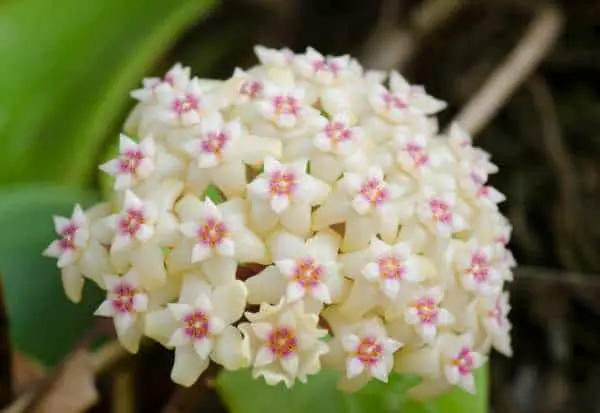
Hoya
Hoya plants are better known as wax plants. These are the vine, shrub, and evergreen perennial creeper. When flowering, they adorn some gorgeous star-shaped flowers with leaves that can either be smooth or feel soft felt. Hoyas are very low maintenance, which is one reason they are so popular for a houseplant.
Hoyas are another plant that doesn’t take over-watering too. Depending on the growing conditions, Hoyas can have flowers 1/4 inch in diameter up to 4” in diameter. There are many different Hoya’s choosing from, 200 species to be exact, and they all boast their own unique colors and shapes. So choosing the hoya, you desire is half the battle to growing and nurturing them.
Tips for Growing Hoya Hydroponically:
- When pruning, avoid cutting the long tendrils, these are where flowers develop.
- Hoyas require adequate drainage so they are not accidently over watered.
- Likewise, this tropical plant can absorb moisture through the air, which is what makes it so low maintenance. Consider a system that uses humidity.
- Hoyas prefer bright indirect light. What they don’t like are dark corners or direct sun. Hoyas can handle cooler weather from 50 degrees F up to warm temperatures of 77 F.
- Maintain a pH range of 5.0-6.5
Fun Facts about Hoya
- Even though there are over 200 different variations of hoya, you won’t find blue, purple, or violet colors represented.
- Some species of Hoya have a Crassulacean Acid Metabolism
- Each cluster of flowers on this plant can contain up to 40 individual flowers.
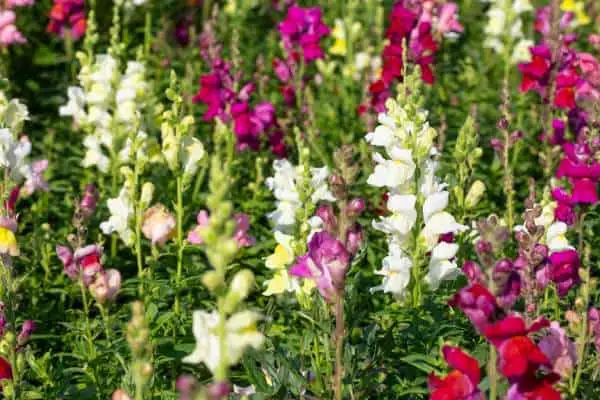
Snapdragons
The botanical name for Snapdragons is Antirrhinum and means ‘like a snout.’ This plant is native around Europe and North America. They have become a popular favorite because of their vibrant hues, and their flowers that resemble a dragon-like mouth when pressed.
Mature Snapdragons can grow from 6 inches up to 48 inches depending on the variety, and the growing conditions. This means you may require some support for your plant, and the growing medium will need to hold them firm. Perlite is often the more common.
Even when grown in a soil-based medium, it’s common to grow flowers like snapdragons indoors before transferring them. This is because they are very sensitive to weather conditions. There are over 18 different snapdragons, and all these deliver bloom colors of pink, yellow, red, white, purple, peach, orange, and bi-colored.
Tips for Growing Snapdragons Hydroponically:
- Snapdragons need adequate watering but not standing in moist conditions. Your growing medium will need to dry between cycles.
- Snapdragons are perennials that require full sun with only occasional shade.
- They prefer pH levels between 6.2 and 7.0.
Fun Facts about Snapdragons
- Often called Dog’s Mouth, Lion’s mouth, Dragon flower and more depending where you are.
- The leaves and flowers have some anti-inflammatory abilities.
- We can apply them as poultices for ulcers or tumors
- When snapdragons are mixed with tea, they can help detoxify the blood and increase urine production to clear the body from waste.
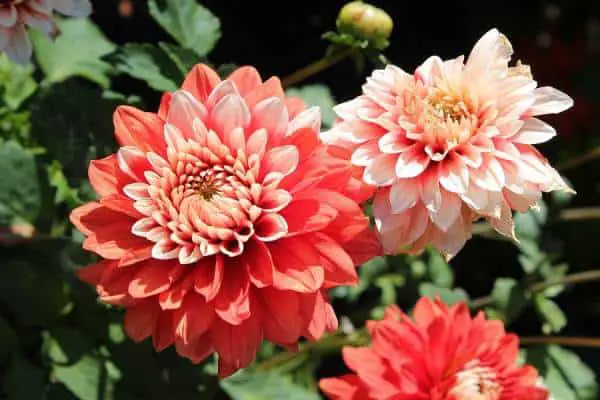
Dahlias
Dahlias are closely related to sunflowers, daisies, zinnia, and chrysanthemums. We know dahlias as octoploids, which means they have eight sets of homologous chromosomes.
If you grow these in your hydroponic system, you will need to be sure they have lots of space. As you are planting in a container, this does need to be at least 12 inches deep. Some varieties require deeper which can rule these out of your system. Dahlias grow half as wide as they do tall; so lateral space is important.
Dahlias like to have lots of light, and they are thirsty feeders. Your growing medium should dry out between watering schedules, and you will need to monitor your tank levels. Once planted, you will need to fertilize with a 10-10-10 NPK mix.
Tips for Growing Dahlias Hydroponically:
- Dahlias need constant light to bloom and grow. It’s recommended that they receive a minimum of eight hours daily.
- Dahlias are spring-planted flowers. This means they prefer warmer temperatures. Stick to a minimum of 60-degree temperatures and a maximum of 72 degrees.
- If you prefer your dahlia’s being shorter and bushier, cut the center shoot above the third set of leaves to encourage shorter growth
- Dahlias need a pH level range of 6.5-7.5.
Fun Facts about Dahlias
- There are over 20,000 cultivars of Dahlia.
- It’s the official flower of Seattle, WA although they are not native to the area.
- Dahlias were known as a vegetable in the 18th century but later became more known as flowers.
- They named them after 18th-century botanist, Anders Dhal.
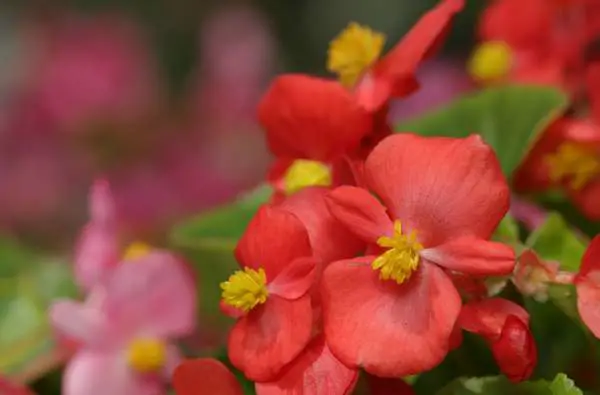
Rex Begonias
Rex Begonias are unique in every sense. We do not know them for their flowers, rather their leaves and foliage. This is colorful and can be overlaid onto the thick fibrous leaves. It is possible to find a myriad of color options from maroon, lavender, gray, silver, pink, and red.
Rex Begonias were first noted in 1856 when a shipment of orchids to England included the mysterious plant that no one could identify. This plant is tropical and native to South America, Africa, and Southeastern Asia. There are over 1,831 species of begonia, each with its own intricate and original leaf appearance.
Tips for Growing Rex Begonias Hydroponically:
- Since Rex Begonias are tropical and subtropical plants, they are native to jungle types of environments. It is this, which makes them great as houseplants as they require little light and prefer shaded and cool areas.
- These plants can grow from 12 inches to 24 inches in height. With leaves growing an average of 4-5 inches, it is also crucial to be wary of outward growing space requirements.
- You can tell when the Rex begonia has received too much light, as the foliage will turn brown.
- Stick to temperatures between 60 and 85 F.
- Maintain a pH range of about 5.7 to 6.2 for optimal growth.
- Rex Begonias like humid conditions; this may mean misting their leaves early in the day.
Fun Facts about Rex Begonias
- You can propagate Begonias by using stem cuttings.
- The Begonia stem is actually designed to store water so that during dry periods of the year, the Begonia remains hydrated.
- Begonias only have a life span of about 2 to 3 years on average. They can live a few years longer if they live in an excellent and nurturing environment.
- The juice of the begonia plant is thought to relieve headaches and as an eyewash for conjunctivitis.
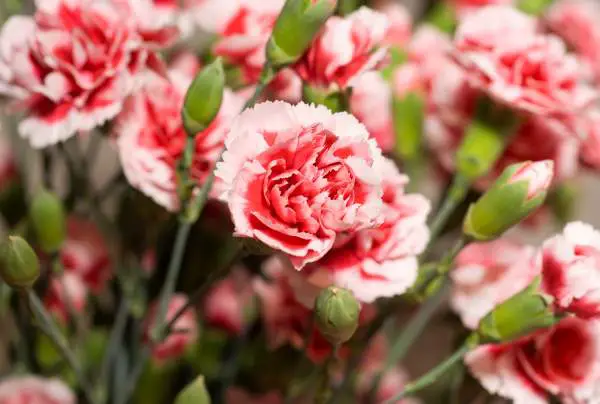
Carnations
Carnations are by far one of the most popular flowers to be grown in hydroponic systems. They are also one of the most commercially grown flowers because of the number of individuals who have them as indoor decorations.
Carnation petals have a fantastic aroma and make any room feel inviting when they have a presence. On top of this, the leaves can also be edible and are sweet to the taste. Growing from cuttings is often the preferred method. If propagating in soil, it can take between two and three weeks when from seeds. Hydroponics can speed up this process.
Tips for Growing Carnations Hydroponically:
- Make sure carnations receive 5-8 hours of uninterrupted sunlight daily.
- Carnations will thrive the best with a pH level of around 6.0.
- Rockwool starter plugs are ideal for seedlings up to 4 to 5 inches in height, at this stage, we can transplant them.
- Keep the temperature range of 65 to 75 F.
- Ebb and Flow, Dutch bucket or DWC systems are best suited to Carnation growth. They will need support when they grow.
Fun Facts about Carnations
- Carnations are believed to be native to the Mediterranean area. However, because of extensive cultivation over the last 2,000 years, no one knows for certain where their origins lie.
- Annual carnations, border carnations, and perpetual flowering carnations are the most common types that are grown.
- Greeks and Romans used carnations in garlands.
- Carnations are a bisexual flower. This means they have both male and female reproductive structures that inhibit better growth and production.

Orchids
For many people, Orchids are among the most beautiful flowers there are. Around the globe, they are a gardener’s favorite thanks to their woody-thick roots and colorful blooms. One thing many lovers of this plant are unaware of is, around the world, most of these are actually grown in hydroponics systems.
The reason for this is that where these Orchids grow in tropical climates, they latch themselves to tree bark or in between rocks. As the climate can be wet, it exposes them to sufficient watering from the rain. Once the rain stops, it exposes the roots to the air and can have plenty of uptake of oxygen.
Add to this surrounding organic matter which rots, and they have a steady stream of nutrients. This is hydroponics in its purest form, and it is what makes growing Orchids in a proper system so easy and so rewarding.
Tips for Growing Orchids Hydroponically:
- Use Hydroton pebbles or similar media that has sufficient drainage and allows maximum airflow to the root systems.
- Maintain temperatures between 60 and 80 F. Orchids also need high humidity levels and air circulation.
- A pH range between 5.5 and 6.5 is best for orchids.
- Lighting can comprise a 400w high-pressure sodium or metal halide bulb. Orchids will use more water when under strong lights.
- Once your orchids flower, you can then place them around your home on display.
Fun Facts about Orchids
- The flowers on orchids can survive for up to 6 months.
- Out of the millions of seeds that orchids produce, less than a hand full will develop into a plant.
- Orchid seeds do not contain endosperm, which is what they need to provide nutrients during germination. Because of this, they require symbiosis with fungi to achieve germination. Germination of orchids can sometimes take up to 15 years.
- They use orchids in the perfume, spice, and medicine industries.
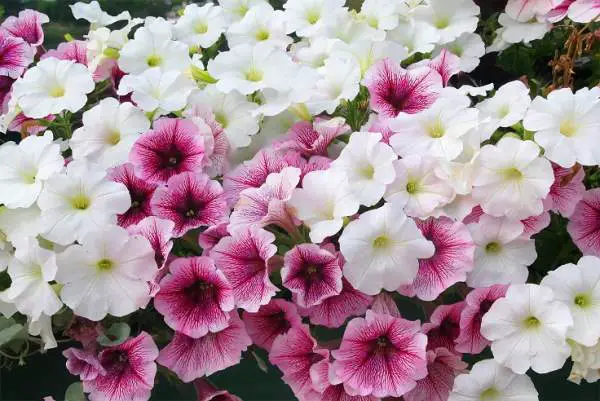
Petunia
These popular South American flowers can withstand hot climates. They are widespread around many gardens in borders and in pots. There is an almost endless range of colors available, which is one reason they are gardeners’ favorites.
Most Petunias you see for sale are hybrids and are developed for specific purposes. As they grow, they can reach anywhere from six inches to four feet in height and have a spread of up to three feet. This means you will require support and lots of spacing to avoid overcrowding.
Tips for Growing Petunias Hydroponically:
- Petunias need at least 5 to 6 hours of full light to thrive at their best.
- When fertilizing Petunias like a balanced mix of 8-8-8, 10-10-10 or 12-12-12.
- In germination, your Petunias will prefer warmer temperatures, however, once they have germinated, move them from this warm area so they can grow in cooler areas. They prefer cooler temperatures between 57 and 65 degrees Fahrenheit.
- Petunias like pH levels of 6.0 to 7.0.
Fun Facts about Petunias
- Petunias are an annual plant, so a full life cycle takes one year.
- Common Petunias are edible and have a sweet and spicy flavor
- There are four groups, which all Petunias fall into. Grandiflora, Multiflora, Milliflora and Hedgiflora.
- Petunia comes from the word “Petun” which means tobacco in Brazil. These two plants are related and can be crossbred.
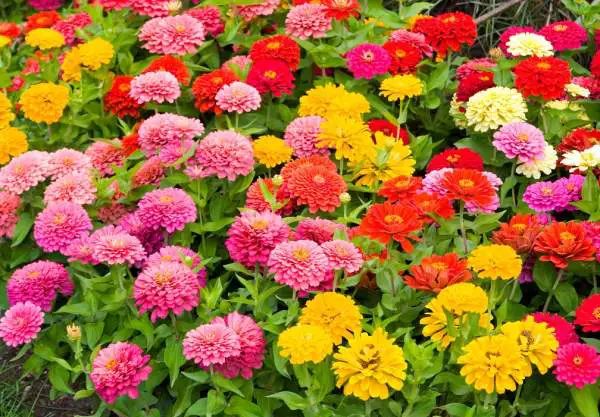
Zinnia
Zinnia is easy to grow and is a part of the daisy family. Being native to the Southwestern United States and South America, they like to grow in full sun. At least six hours of full sun or bright light are recommended to get the best of these colorful plants.
Once they grow, they can range between 4 and 40 inches in height. This means you will require some support and a growing medium that can support their root system.
Their large range of bright colors and ability to withstand hotter climates makes them popular for planting in many a garden environment. Zinnias will reseed themselves each year. When selecting from the many varieties for your hydroponic garden, you will be better off selecting the more compact varieties.
Tips for Growing Zinnia Hydroponically:
- Keep the temperature range between 74 and 84 degrees Fahrenheit. They can grow in temperatures as low as 60 degrees Fahrenheit.
- Zinnias like moist environments yet they don’t like to be over-watered because they can fall foul of root rot. It can cope with dry spells better than standing in water
- Once flowers show, they can benefit from 5-5-5 fertilizers for larger blooms.
- Zinnias prefer pH ranges between 5.5 and 7.5.
- Zinnias like a lot of light, but they can do just well in environments that receive less than 6 hours of light minimum.
- If you want bushier plants, you can pinch the growth tip of the plants when young. This creates shorter side branching plants.
Fun Facts about Zinnia
- Zinnia leaves have a sandpaper-like texture to them.
- They named them after the German botanist Johann Gottfried Zinn.
- They can have single, semi-double, or even double layers of petals.
- By removing dead or faded flower heads, you will see an increase in flower production. We call this dead-heading.
- Butterflies love Zinnia’s, and you’ll find an abundance of them attracted to your garden if you plant them outdoors.
Hydroponic Systems For Growing Flowers

